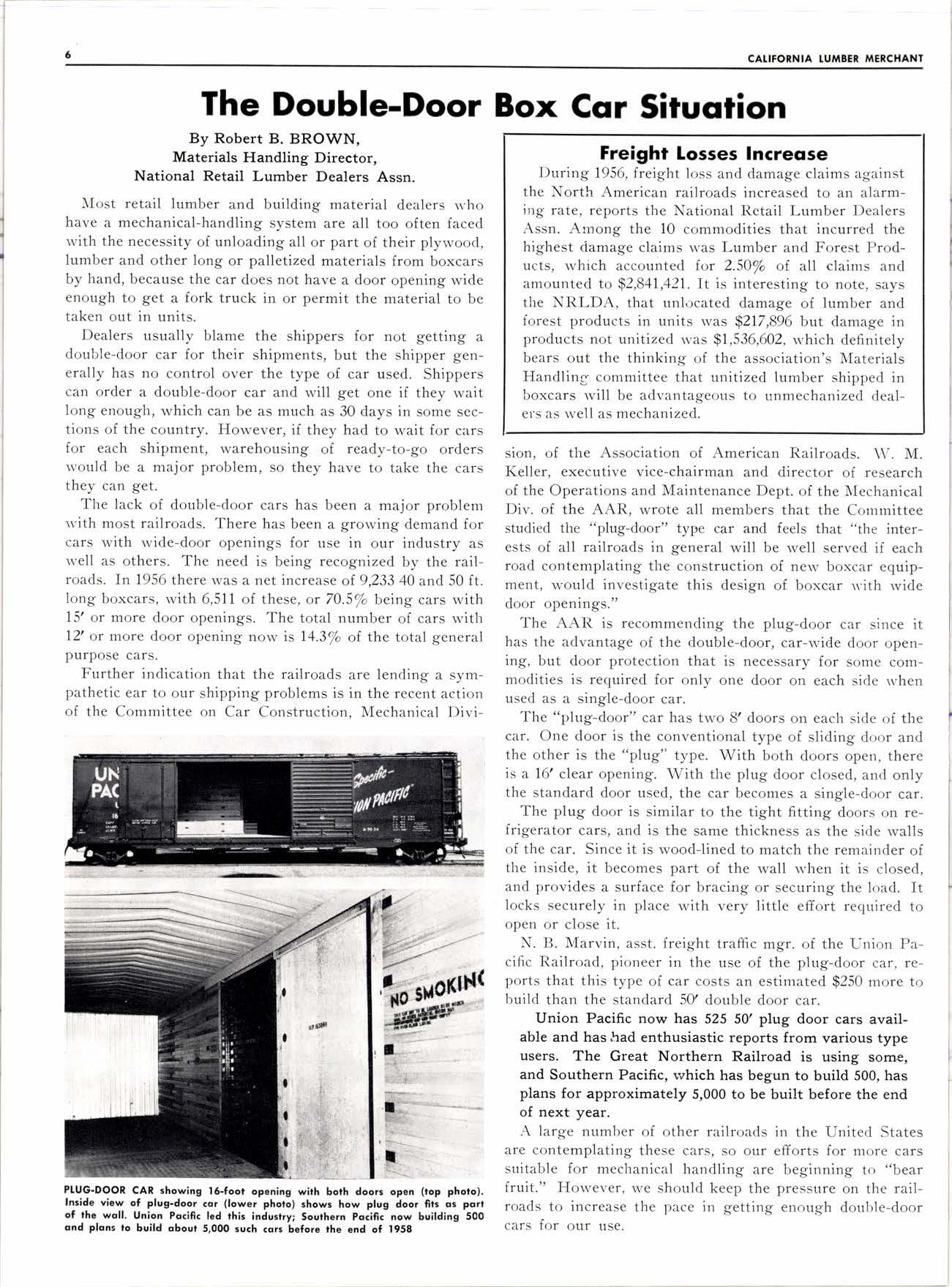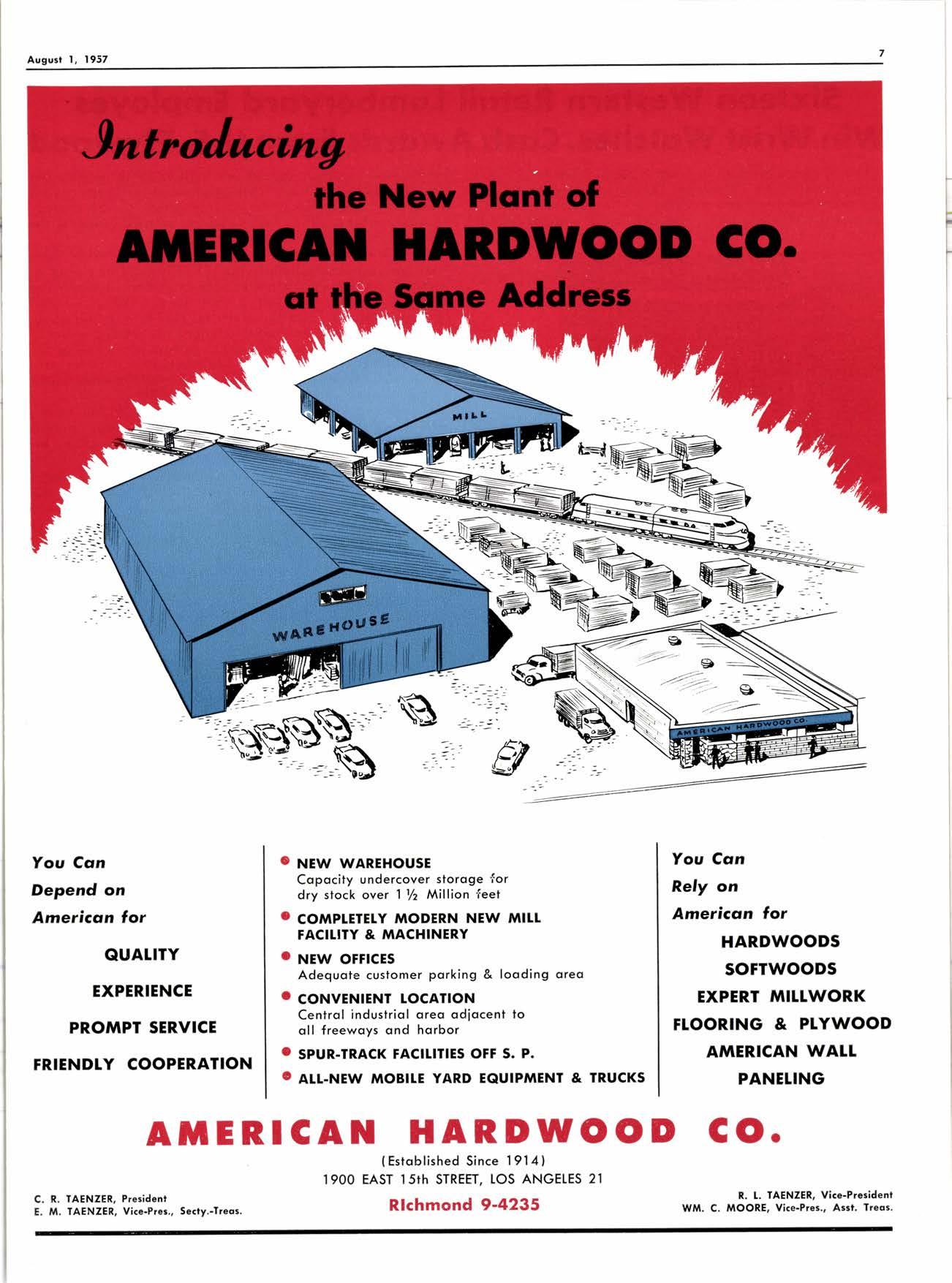
3 minute read
The Double-Door Box Cqr Siruofion
By Robert B. BROWN, Materials Handling Director, National Retail Lumber Dealers Assn.
N{ost retail lumber and building material dealers rvho have a mechanical-handling system are all too o{ten faced rvith the necessity of unloading all or part of their plywood, lumber and other long or palletized materials from boxcars by hand, because the car does not have a door opening wide enough to get a fork truck in or permit the material to be taken out in units.
Dealers usually blame the shippers for not getting a doubie-door car for their shipments, but the shipper generally has no control over the type of car used. Shippers can order a double-door car and will get one if they wait long enough, which can be as much as 30 days in some sections of the country. However, if they had to wait for cars for each shipment, warehousing of ready-to-go orders rvould be a major problem, so they have to take the cars they can get.
The lack of double-door cars has been a major problem rvith most railroads. There has been a growing demand for cars with wide-door openings for use in our industry as well as others. The need is being recognized by the railroads. In 1956 there was a net increase of 9,233 40 and 50 ft. long boxcars, with 6,511 of these, or 70.5% being cars u'ith 15'or more door openings. The total number of cars with 12' or more door opening now is 14.3/o of the total general purpose cars.
Further indication that the railroads are lending a sympathetic ear to our shipping problems is in the recent action of the Committee on Car Construction. Mechanical Divi-
Freight fosses Increose
During 1956, freight loss and damage claims against the North American railroads increased to an alarming rate, reports the National Retail Lumber Dealers Assn. Arnong the 10 commodities that incurred the highest damage claims was Lumber and Forest Products, which accounted fot 2.50/o of all claims and amounted to $2,841,421. It is interesting to note, says tire NRLDA, that unlocated damage of lumber and forest products in units rvas $217,896 but damage in products not unitized u'as $1,536,602, rvhich definitely bears out the thinking of the association's Materials Handlinc- committee that unitized lumber shipped in boxcars rvill be advantageous to unmechanized dealels as well as mechanized.
sion, of the Association of American Railroads. W. M. Keller, executive vice-chairman and director of research of the Operations and Maintenance Dept. of the Mechanical Div. of the AAR, wrote all members that the Committee studied the "plug-door" type car and feels that "the interests of all railroads in general will be well served if each road contemplating the construction of nerv boxcar equipment, would investigate this design of boxcar l'ith rvide door openings."
The AAR is recommending the plug-door car since it has the advantage of the double-door, car-rvide door opening, but door protection that is necessary for some commodities is required for only one door on each side rvhen used as a single-door car.
The "plug-door" car has two 8'doors on each side of the car. One door is the conventional type of sliding door and the other is the "plrg" type. With both doors open, there is a 16' clear opening. With the plug door closed, and only the standard door used, the car becomes a single-door car.
The plug door is similar to the tight fitting doors on refrigerator cars, and is the same thickness as the side walls of the car. Since it is wood-lined to match the remainder of the inside, it becomes part of the wall when it is closed, and provides a surface for bracing or securing the load. It locks securely in place with very little effort required to open or close it.
N. B. Marvin, asst. freight traffic mgr. of the Union Pacific Railroad, pioneer in the use of the plug-door car, reports that this type of car costs an estimated $250 more to build than the standard 50 double door car.
Union Pacific now has 525 50'plug door cars available and has had enthusiastic reports from various type users. The Great Northern Railroad is using some, and Southern Pacific, rvhich has begun to build 500, has plans for approximately 5,000 to be built before the end of next year.
A large number of other railroads in the United States are contemplating these cars, so our efforts for more cars suitable for mechanical handling are beginning to "bear open (rop photo). fruit." Holvever, we should keep the pressure on the raildoor.fits.os p_orf roads to increase the pace in getting enough double-door now building 50O 1958 CarS lor Our use.











